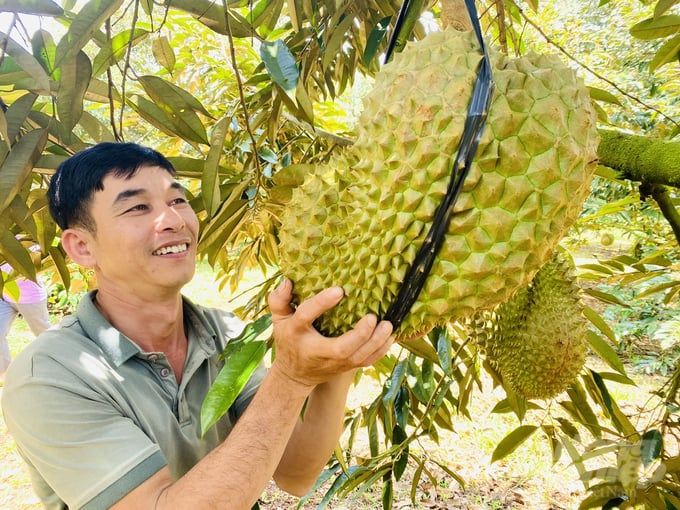
The traders are purchasing durian. Photo: Nguyễn Thủy
Still facing competition for purchase and sale
In recent years, durian has been easily consumed, with prices remaining high, allowing farmers to earn large profits. As a result, durian production has rapidly increased, especially in the Southeast, the Mekong Delta, and particularly in the Central Highlands, where durian is grown intercropped with coffee.
According to the Ministry of Agriculture and Rural Development (MARD), from 2016 to 2022, the total durian cultivation area nationwide grew from 32,000 hectares to over 112,200 hectares. The average yield of durian has seen a slight increase, ranging from 14.7 to 15.7 tons per hectare. Notably, durian production surged, from 366,000 tons to over 863,000 tons, increasing by 11.7% per year.

Price increase from November 2023 to February 2024
From November 2023 to February 2024, durian prices soared as only durian from the Mekong Delta was available. The price of Ri6 durian ranged from 120,000 to 150,000 VND per kilogram, and Dona durian ranged from 140,000 to 190,000 VND per kilogram.
Mr. Vu Duc Con, Deputy Director of the Dak Lak Department of Agriculture and Rural Development and Chairman of the Dak Lak Durian Association, stated that the Ministry of Agriculture and Rural Development, along with local and central agencies, has been focusing on addressing challenges and promoting the development of the durian industry. In addition, businesses and farmers are responsible for building technical processes, improving quality, and developing brands, trademarks, and the reputation of Vietnamese durian in international markets. As a result, durian prices have increased in recent years, helping farmers and businesses boost income and stabilize production.
However, Mr. Con noted that the durian industry still faces many challenges. For instance, the durian production areas are still fragmented, and there is no large-scale cultivation area. The technical expertise of farmers is also lacking, both in terms of producing goods professionally according to the requirements of importing countries. There is insufficient cooperation between the growers, exporters, and farmers, and the relationships are not transparent or sustainable.
“There are many cases where, after being assigned a planting area code, the quality control during packaging and the implementation of plant quarantine requirements for export are not maintained. There are also instances of fraud, with some parties stealing planting area codes, creating competition for purchasing and selling, and instances where farmers break contracts,” he said.
Moreover, there are no specific regulations or guidelines for issuing and managing planting area codes, nor are there penalties for violations. The application of information technology in production, harvesting, processing, packaging, and exporting remains inadequate.
The Deputy Director of Dak Lak’s Department of Agriculture and Rural Development also mentioned that in the near future, the local authorities would finalize a development plan for durian and avocado production for the period 2025-2030. This plan will prioritize creating specialized farming areas to facilitate mechanization and product consumption. Information about durian cultivation planning will be disseminated through media channels for farmers to stay updated.

Durian production to increase by at least 20%
Although it has only recently entered the official export market, Vietnamese durian has already set records for breakthrough growth, becoming the "king of fruits" in Vietnam, with an export value of 2.2 billion USD. The main export markets are China, Japan, and Australia, primarily for fresh and frozen durians.
Vietnam’s proximity to China, the world’s largest durian consumer, helps reduce logistics costs. Additionally, the impact of the Red Sea crisis has made it more difficult for goods from other countries to enter the Chinese market due to transportation time and cost. Vietnam has signed 17 free trade agreements, many of which offer tariff reductions, providing a competitive advantage for durian and other Vietnamese agricultural products in China.
According to data from the General Department of Customs, in 2023, China spent over 6.7 billion USD (for over 1.4 million tons) on durian imports. Among these, Thailand exported about 928,000 tons (worth over 4.5 billion USD), while Vietnam exported nearly 494,000 tons (worth over 2.1 billion USD), and the Philippines exported over 3,700 tons (worth 13.2 million USD).
“China has issued over 700 durian planting area codes for Vietnam (more than 400 in 2023). The Ministry of Agriculture and Rural Development is continuing to negotiate with China regarding the issuance of planting area codes and packaging facility codes for durian, as well as approval for exporting frozen durian. It is expected that this year’s durian production will increase by at least 20% compared to last year. Vietnam’s durian will continue to grow, especially in the Chinese and ASEAN markets,” said Mr. Dang Phuc Nguyen, Secretary General of the Vietnam Fruit and Vegetable Association.
Experts predict that there will be more opportunities for Vietnamese agricultural products, especially durian, in the coming years. The Chinese market will continue to have increasing demand for durian, and other markets, including Thailand, are becoming increasingly interested in importing Vietnamese durian.
The Ministry of Agriculture and Rural Development is also negotiating with India to allow the export of durian to India and discussing the export of frozen durian to China. Thus, there is significant potential for durian exports. However, quality will remain the deciding factor in capturing market share.
Dong Nai is the fourth largest province in Vietnam in terms of durian cultivation, with nearly 11,350 hectares. Durian farming has helped many farmers in Dong Nai escape poverty and achieve wealth. In 2024, Dong Nai will continue to expand the number of planting area codes, improve the quality of existing area codes, and apply modern farming technologies to ensure product traceability.
To ensure the sustainable development of the durian industry, the province is encouraging farmers, cooperatives, and businesses to fully comply with export market standards, enhance export activities, and attract investment in deep processing to improve the quality of durian from Dong Nai and Vietnam in general.




